Yosemite National Park Fungal Survey
The flora and fauna of Yosemite National Park have been studied extensively for decades. This summer, for the first time, a consortium of professional and amateur mycologists is scouring the park for fungi. The inventory of mushrooms is key to a better understanding of their role in the various park ecosystems, whether by breaking down dead wood or bringing nutrients to trees and plants.
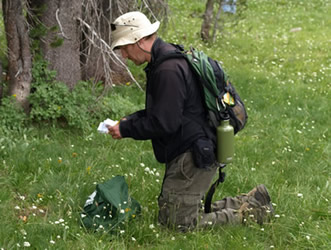
Ron Bosia documenting fungi near Tuolumne Meadows
© photo by Debbie Viess
The survey is being conducted by small, informal groups of mycologists who are following an exacting protocol of collection, identification, photography and vouchering specimens for future scientific research. All of the fungi collected are given a unique identifying number, a picture is posted on http://mushroomobserver.org, and the dried fruit body saved in a park or university herbarium.
Because fungi can be found in so many of the park’s habitats, it is likely that the total number of species found will number in the thousands. Mycologists may even discover some fungi that have not yet been described or have been rarely seen in other parts of the Sierra.
On a recent August trip to Tuolumne Meadows, a group of five Bay Area mycologists were joined by NPS staff Dr. Alison Colwell, Interdisciplinary Resources Biologist, and Dr. Carol Blaney, Mather Lead Interpreter, as additional spotters in the hunt for the unique fungi found in sub-alpine habitats.
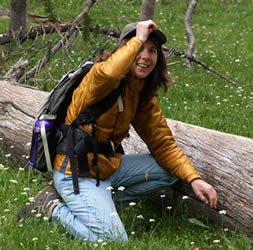
Dr. Carol Blaney helps find mushrooms
© photo by Debbie Viess
This survey was initiated by professional mycologists Dr. Tom Bruns, UC Berkeley Department of Plant and Microbial Biology, and Dr. Dennis Desjardin, SFSU Department of Biology. Many skilled amateur mycologists are also participating in the survey because of their expertise in mushroom identification.
So far, over 500 mushrooms have been carefully photographed, collected — with the location and habitat carefully described, and dried for future study. Some of the unusual fungi are going through an extra step: a sterile instrument is used to collect a small piece of tissue from the mushroom, and smashed with a hammer onto a special Whatman FTA Plant Card™ to preserve DNA.
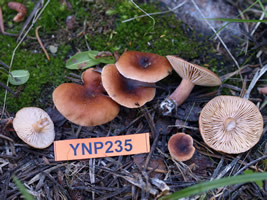 |
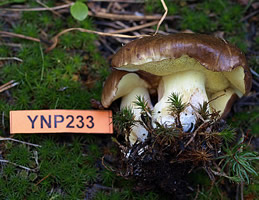 |
|
Lactarius alpinis var. mitis |
Suillus species |
As the snow melted this spring, collectors combed the lower elevations in the South end of the park and in the Valley. As the snow retreated, they next explored Hwy 120 and the Crane Flat area. In early August, mycologists were finally able to survey near White Wolf and Tuolumne Meadows. They found several rare fungi in the Gastroboletus group at Tuolumne.
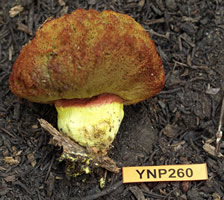 |
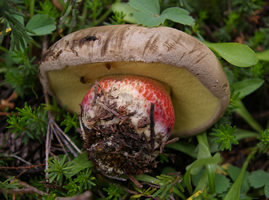 |
|
Gastroboletus vividus, collected near Siesta Lake |
|
Boletus calopus var. frustosus collected near Mono Pass trailhead |
